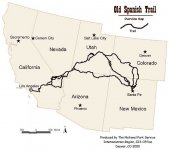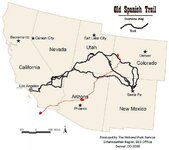I need to make a confession ...........
I'm beginning to spend an inordinate amount of time on this treasure forum. Too much of anything is not good, but I just cant help it ! I will venture out in the spring and do research in Indiana. I will take my kids, because I know they are interested as well. The treasure is in the fun of the hunt, and the search for history.
I, however, would love to get the chance to look for S/S out West as many of you do. As a newbie (and I am sure there are plenty of them on here) I have been lucky to hear the words of many a wise person here .... Old Dog, desertmoons, rangler, shortstack and more. The first step should be research. One should not just go out and start wandering off in the desert. I would guess that's why some don't come back !
My question: If you were a newbie and wanted to get a bit more serious. (and certainly not divulging any locational info)
1) Where would you begin your search for treasure signs (state, range) ?
2) How many people would you go with ?
3) How would you go out ? (horseback, ATV, RV, commute ?)
4) What is the best time of year to do so ? (I have heard about the unbearable heat at certain times, some times as "snake seasons", and only certain times for the right shadows)
5) How do you prepare for the dangers ? (snakes, critters, traps, prying eyes)
6) Is this something you can do for a week or 2 a year on vacation or is it more prudent to wait for retirement
I know many of you are seasoned and these things are just "understood", but I would love to know the differences in how all of you vets do what you do.
I'm beginning to spend an inordinate amount of time on this treasure forum. Too much of anything is not good, but I just cant help it ! I will venture out in the spring and do research in Indiana. I will take my kids, because I know they are interested as well. The treasure is in the fun of the hunt, and the search for history.
I, however, would love to get the chance to look for S/S out West as many of you do. As a newbie (and I am sure there are plenty of them on here) I have been lucky to hear the words of many a wise person here .... Old Dog, desertmoons, rangler, shortstack and more. The first step should be research. One should not just go out and start wandering off in the desert. I would guess that's why some don't come back !
My question: If you were a newbie and wanted to get a bit more serious. (and certainly not divulging any locational info)
1) Where would you begin your search for treasure signs (state, range) ?
2) How many people would you go with ?
3) How would you go out ? (horseback, ATV, RV, commute ?)
4) What is the best time of year to do so ? (I have heard about the unbearable heat at certain times, some times as "snake seasons", and only certain times for the right shadows)
5) How do you prepare for the dangers ? (snakes, critters, traps, prying eyes)
6) Is this something you can do for a week or 2 a year on vacation or is it more prudent to wait for retirement

I know many of you are seasoned and these things are just "understood", but I would love to know the differences in how all of you vets do what you do.








